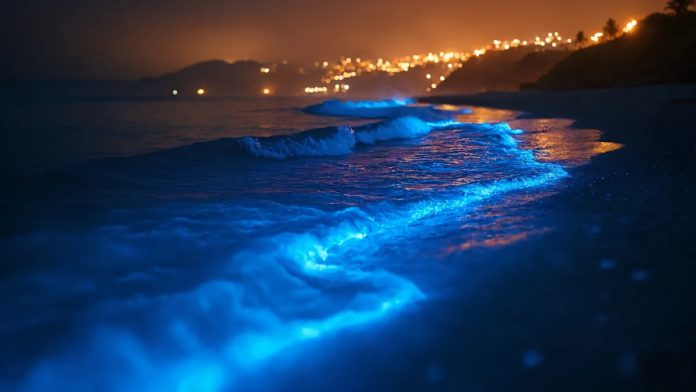Bioluminescence is one of those natural phenomena that you simply have to see to believe. The idea of shores glowing with a glittering, blue-green light sounds like something out of a fever dream, but there are, in fact, places across the U.S. where the rare phenomenon of bioluminescence can be seen in the water. Much like chasing views of the northern lights, visiting bioluminescent beaches is a form of noctourism — traveling to destinations for nocturnal sightseeing. Bioluminescent organisms only glow at night, typically an hour or two after sunset, and the glow is especially pronounced on dark, moonless nights, in places with minimal light pollution.
The key to knowing where and when to see bioluminescent waters is understanding how the organisms that produce the light function. Many aquatic critters produce bioluminescence, but most come from Noctiluca scintillans, a dinoflagellate (plankton) that emits light when disturbed as a biological mechanism for startling predators. For that reason, you’ll typically only see the glow in the crashing waves, or if you swoosh your hand through the water. The organisms are drawn to areas in the water that are nutrient-rich, so they may appear more abundant after rainfall, which brings in more nutrients.
It’s more common to find bioluminescent beaches in tropical or subtropical regions, since warmer temperatures are also more suitable for the phytoplankton. With that said, bioluminescence is notoriously unpredictable and can occur in waters as cold as those around Antarctica. For that reason, the best way to maximize your chances of seeing the glow is to head to beaches that have a strong reputation for bioluminescent sightings. We compiled places across the U.S. that have frequently been cited as hosting bioluminescence from firsthand experiences shared in reviews, blogs, and forum posts.
Read more: The 5 Cheapest Islands In Hawaii For Your Next Tropical Vacation
Parrish Park, Titusville, Florida

Pier at Parrish Park in Titusville, Florida – SHoener/Shutterstock
There are several Florida destinations that are great for seeing bioluminescent waves, but it’s the Indian River Lagoon that’s most consistently aglow with bioluminescent organisms. The lagoon extends over 150 miles along Florida’s East Coast, from Daytona Beach to West Palm Beach, and is particularly known for its resplendent ecological diversity and rare species. When it comes to those that emit light, you’re more likely to see them in the northern, more remote areas of the lagoon.
That’s what gives Parrish Park in Titusville a leg up among the lagoon’s bioluminescent spots: It’s far enough from the light pollution of busier areas, while still being quite accessible for travelers, only about a 45-minute drive from the Orlando International Airport.
The bioluminescence around Parrish Park is so prominent that you can often see it just from gazing out from the shore. “My favorite spot was Parish [sic] Park across the Max Brewer Bridge … you don’t have to even leave shore to see [the bioluminescence],” wrote one Reddit user. “Find a spot that is protected from streetlights so it’s dark and you’ll be able to see it.” Of course, if you want to get up close to it, kayaking through the lagoon is an indelible experience. There are many kayak tour services available that launch from Parrish Park, and some offer tours in transparent kayaks, so you can see the illumination activate under your seat as you paddle through.
Torrey Pines State Beach, San Diego, California

Bioluminescent surf on the San Diego coast – Richard Art Gallary/Shutterstock
San Diego’s beaches are some of the most fascinating for bioluminescence seekers. They’re so rich with dense groups of phytoplankton — in the form of algal blooms — that sometimes the waves appear a reddish color. At night, those same red-colored blooms turn bright blue as they’re stimulated by the lapping waves. If you want to get the clearest views of the illuminated waves, you have to find spots with minimal light pollution from the city. Look no further than Torrey Pines State Beach, a local favorite among San Diego’s best vacation beaches, which travel blogger Maria of San Diego Explorer described as “one of the darkest spots in the city” and “finest places to see glowing plankton.”
Since Torrey Pines State Beach is part of a state park, it officially closes at sunset, but that doesn’t mean the whole beach is inaccessible at night. Head to the northern part of the beach, where it falls outside of the park’s bounds, and park along North Torrey Pines Road just beyond the park’s lot. From here, you’ll be able to see the glowing waves crest along the shore. Torrey Pines State Beach is also popular with surfers, and sometimes surfers come here at night to ride through the glowing water.
The bioluminescence in San Diego fluctuates and occurs in bursts a few times a year when the blooms appear for several nights, though it’s most prevalent in early spring and late summer.
Jackson Beach, San Juan Island, Washington

Sunrise over an old fishing pier at Jackson Beach on San Juan Island, Washington – Matt Ragen/Shutterstock
Jackson Beach is located on the most populous island of the San Juan Islands archipelago in Washington, San Juan Island itself, which is iconic for its mesmerizing bioluminescent waters. Unlike many of the well-known spots for seeing bioluminescence around the island, which are in more secluded bays, you don’t need a kayak to catch a glimpse of the glow at Jackson Beach. Bioluminescent plankton are bountiful around the island because of the strong currents of the Salish Sea, churning up nutrients that allow microorganisms to thrive. In the island’s bays, where the waters are shallower and sheltered, the organisms can accumulate profusely. Jackson Beach sits along Griffin Bay, one that’s particularly known for harboring the plankton.
“Here in Griffin Bay, high concentrations of bioluminescent organisms put on a fireworks show when the water is disturbed,” said travel blogger Char Across the World. Jackson Beach is an easy access point to Griffin Bay from the island’s main port, Friday Harbor, reached by car in about five minutes or on foot in 30 minutes. Once there, if there’s a prominent bloom, you’ll be able to see bioluminescence from the driftwood-covered shore. You can run your hands through the water to stimulate the glittering organisms. There’s a launch point for kayaks and small boats from Jackson Beach, too, and paddling out to the bay with the bioluminescent bloom gleaming in your wake makes for an utterly magical experience.
Stony Beach, Cape Cod, Massachusetts

Shore of a small beach in Woods Hole, Cape Cod – Yingna Cai/Shutterstock
The Northeast isn’t known for having bioluminescent beaches, but Cape Cod, Massachusetts, is a marvelous exception. Falmouth, a beach town located across from Martha’s Vineyard with fun shops and art, is most likely your best bet for finding bioluminescence on the Cape. Closer to Woods Hole, the small but pretty Stoney Beach has had multiple reports of bioluminescence in the waters. One Reddit poster wrote, “I was night swimming at Stoney Beach like three weeks ago and the bioluminescence was there … It looks like little sparks flying through the water as you swim.”
What’s particularly special about the glow here is that it’s not only caused by phytoplankton, but also by another glowing creature called the comb jelly. Waters around Cape Cod and Martha’s Vineyard are home to comb jellies, an organism similar to a jellyfish that is naturally bioluminescent. Like the plankton, they produce light when roused by waves and boats (and you don’t need to worry about going into the water with them, since comb jellies don’t sting).
Despite its name, Stoney Beach isn’t rocky at all, and it’s a lovely area for sunbathing and swimming during the day. To catch a glimpse of bioluminescent water, you’re most likely to see it in the summer months, after dusk but before midnight. Just note that Stoney Beach, though publicly accessible, is owned by the Marine Biological Laboratory, and at least one visitor has noted that the laboratory closed off beach access around 10 p.m.
Tomales Bay, California

Tomales Bay at night, Northern California – ddub3429/Shutterstock
San Diego isn’t the only hotspot for bioluminescence in California. Its northern counterpart can be found at Tomales Bay, an inlet adjacent to Point Reyes National Seashore. Tomales Bay is known for both its oysters and its beautiful beaches, but for noctourists, it’s the potential of spotting glowing phytoplankton that’s its real appeal. The high visibility of the bioluminescence here is at least partly due to the foggy nights, which darken the sky, simultaneously allowing the blue shimmer to stand out.
John Granatir, who started the kayaking tour company Blue Waters Kayaking that specializes in Tomales Bay bioluminescence tours, described the sight of the phenomenon during an interview in Northbay Biz: “I mean, literally, you see the water dripping off your paddle and it’s like a little fiery cascade of water dripping off your paddle into the sea.”
The bioluminescence appears most vibrantly in Tomales Bay around late summer and early fall, when the waters are calmer but still warm. The western side of the bay has the most promising outlook for spotting bioluminescence, and kayaking tours often lead towards the western shore, farther from light pollution. If the bloom is bright enough, you’ll be able to see the glowing water from the shore. However, your chances are better if you paddle out into the bay, since the organisms might need to be stirred up from beneath the water surface. There are two public launch points at Hearts Desire Beach and Millerton Point, but it might be a good idea to paddle out with a tour, as fog can make the bay hard to navigate.
Methodology

Bioluminescence water one the coast of San Diego, California – Ianmcdonnell/Getty Images
To find the best beaches for seeing bioluminescence in America, we dug into accounts from people who have actually been to each of these shores, drawing from travel blogs, online reviews, magazine features, and local Reddit threads. Each location was cross-referenced across multiple sources to confirm that the sightings weren’t one-time events. Beaches were evaluated based on a few key factors: the consistency of reported bioluminescence sightings, visibility of the glow from shore, and public access to each spot (we didn’t include places that might only be accessible by paddling out to a remote cove, for example).
Ready to discover more hidden gems and expert travel tips? Subscribe to our free newsletter and add us as a preferred search source for access to the world’s best-kept travel secrets.
Read the original article on Islands.








